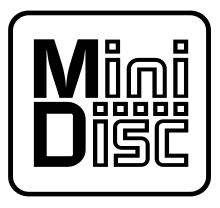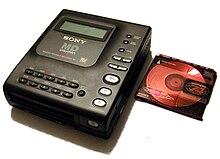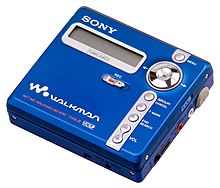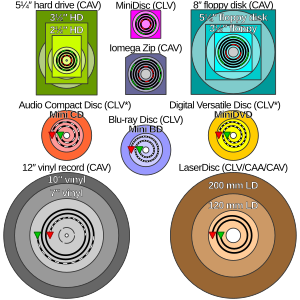MiniDisc
 | |
 The Sony MZ1, the first MiniDisc player, released in 1992. | |
| Media type | Magneto-optical disc |
|---|---|
| Encoding | ATRAC, linear PCM (with Hi-MD) |
| Capacity | 80 min (standard MiniDisc), up to 45 hours of audio (1 GB capacity) (with Hi-MD) |
| Read mechanism | 780 nm laser |
| Write mechanism | Magnetic field modulation |
| Developed by | Sony |
| Usage | Audio storage, Data storage (with Hi-MD) |
| Released | September 1992 |
| Optical discs |
|---|
MiniDisc (MD) is a magneto-optical disc-based data storage format offering a capacity of 60, 74 minutes and, later, 80 minutes, of digitized audio or 1 gigabyte of Hi-MD data. Sony brand audio players were on the market in September 1992.[1]
Sony announced the MiniDisc in September 1992 and released it in November of that year for sale in Japan and in December in Europe, Canada, the US and other countries.[2] The music format was originally based on ATRAC audio data compression, but the option of linear PCM digital recording was later introduced to meet audio quality comparable to that of a compact disc. MiniDiscs were very popular in Japan and found moderate success in Europe.[3]
Sony has ceased development of MD devices, with the last of the players sold by March 2013.[4]
Market history
In 1983, just a year after the introduction of the Compact Disc, Kees Schouhamer Immink and Joseph Braat presented the first experiments with erasable magneto-optical Compact Discs during the 73rd AES Convention in Eindhoven.[5] It took, however, almost 10 years before their idea was commercialized.
Sony's MiniDisc was one of two rival digital systems, both introduced in 1992, that were targeted as replacements for the Philips Compact Cassette analog audio tape system: the other was Digital Compact Cassette (DCC), created by Philips and Matsushita. Sony had originally intended Digital Audio Tape (DAT) to be the dominant home digital audio recording format, replacing the analog cassette. Due to technical delays, DAT was not launched until 1989, and by then the U.S. dollar had fallen so far against the yen that the introductory DAT machine Sony had intended to market for about $400 in the late 1980s now had to retail for $800 or even $1000 to break even, putting it out of reach of most users.
Relegating DAT to professional use, Sony set to work to come up with a simpler, more economical digital home format. By the time Sony came up with MiniDisc in late 1992, Philips had introduced a competing system, DCC. This created marketing confusion very similar to the Betamax versus VHS battle of the late 1970s and early 1980s. Sony attempted to license MD technology to other manufacturers, with JVC, Sharp, Pioneer, Panasonic and others all producing their own MD systems. However, non-Sony machines were not widely available in North America, and companies such as Technics and Radio Shack tended to promote DCC instead.
Despite having a loyal customer base largely of musicians and audio enthusiasts, MiniDisc met with only limited success in the United States. It was relatively popular in Japan and the United Kingdom during the 1990s, but did not enjoy comparable sales in other world markets. Since then, recordable CDs, flash memory and HDD and solid-state-based digital audio players such as iPods have become increasingly popular as playback devices.
The initial low uptake of MiniDisc was attributed to the small number of pre-recorded albums available on MD as relatively few record labels embraced the format. The initial high cost of equipment and blank media was also a factor. Mains-powered hi-fi MiniDisc player/recorders never got into the lower price ranges, and most consumers had to connect a portable machine to the hi-fi in order to record. This inconvenience contrasted with the earlier common use of cassette decks as a standard part of an ordinary hi-fi set-up.
MiniDisc technology was faced with new competition from the recordable compact disc (CD-R) when it became more affordable to consumers beginning around 1996. Initially, Sony believed that it would take around a decade for CD-R prices to become affordable - the cost of a typical blank CD-R disc was around $12 in 1994 - but CD-R prices fell much more rapidly than envisioned, to the point where CD-R blanks sank below $1 per disc by the late 1990s, compared to at least $2 for the cheapest 80-minute MiniDisc blanks.
The biggest competition for MiniDisc came from the emergence of MP3 players. With the Diamond Rio player in 1998 and the Apple iPod, the mass market began to eschew physical media in favor of file-based systems.

By 2007, because of the waning popularity of the format and the increasing popularity of solid-state MP3 players, Sony was producing only one model, the Hi-MD MZ-RH1, also available as the MZ-M200 in North America packaged with a Sony microphone and limited Apple Macintosh software support.[6][7][8]
The introduction of the MZ-RH1 allowed users to freely move uncompressed digital recordings back and forth from the MiniDisc to a computer without the copyright protection limitations previously imposed upon the NetMD series. This allowed the MiniDisc to better compete with HD recorders and MP3 players. However, most pro users like broadcasters and news reporters had already abandoned MiniDisc in favor of solid-state recorders, due to their long recording times, open digital content sharing, high-quality digital recording capabilities and reliable, lightweight design.
On 7 July 2011, Sony announced that it would no longer ship MiniDisc Walkman products as of September 2011,[9] effectively killing the format.[10]
On 1 February 2013, Sony issued a press release on the Nikkei stock exchange that it will cease shipment of all MD devices, with last of the players to be sold in March 2013. However, it would continue to sell blank discs and offer repair services.[1]
MD Data
MD Data, a version for storing computer data, was announced by Sony in 1993 but never gained significant ground. Its media were incompatible with standard audio MiniDiscs, which has been cited as one of the main reasons behind the format's failure.[citation needed]
MD Data could not write to audio-MDs, only the considerably more expensive data blanks. In 1997, MD-Data2 blanks were introduced, which held 650 MB of data. They were only implemented in Sony's short-lived MD-based camcorder (the DCM-M1) as well as a small number of multi-track recorders; Sony's MDM-X4, Tascam's 564 (which could also record using standard MD-Audio discs, albeit only two tracks), and Yamaha's MD-8, MD-4, & MD4S.
The Hi-MD format, introduced in 2004, marked a return to the data storage arena with its 1 GB discs and ability to act as a USB drive. Hi-MD units allow the recording and playback of audio and data on the same disc, and are compatible (both audio and data) with standard MiniDisc media - an 80-minute Minidisc blank could be formatted to store 305MB of data.
Recent evidence has emerged that early MD Data discs were recorded in such a way that the resulting tracks could be played back as 14.4K modem data which muted audio on normal players to protect hearing and speakers in much the same way that CDROM players do. This also meant existing R/W optical hardware could read them but not the player's audio circuitry explaining why the format was very short lived due to the data being essentially stored uncompressed and as such could be 1/8 or less i.e. 29MB actual storage capacity. Hi-MD were more analogous to a CDROM.
Design
Physical characteristics

The disc is permanently housed in a cartridge (68×72×5 mm) with a sliding door, similar to the casing of a 3.5" floppy disk. This shutter is opened automatically by a mechanism upon insertion. The audio discs can either be recordable (blank) or premastered. Recordable MiniDiscs use a magneto-optical system to record data. A laser heats one side of the disc to its Curie point, making the material in the disc susceptible to a magnetic field. A magnetic head on the other side of the disc alters the polarity of the heated area, recording the digital data onto the disk. Playback is accomplished with the laser alone: taking advantage of the Faraday effect; the player senses the polarisation of the reflected light and thus interprets a 1 or a 0. Recordable MDs can be recorded on repeatedly; Sony claims up to one million times. As of May 2005, there were 60 minute, 74 minute and 80 minute discs available. 60 minute blanks, which were widely available in the early years of the format's introduction, were phased out long before and are rarely seen.
MiniDiscs use a mastering process and optical playback system that is very similar to CDs. The recorded signal of the premastered pits and of the recordable MD are also very similar. Eight-to-Fourteen Modulation (EFM) and a modification of CD's CIRC code, called Advanced Cross Interleaved Reed-Solomon Code (ACIRC) are employed.
Differences from cassette and CDs

* Some CD-R(W) and DVD-R(W)/DVD+R(W) recorders operate in ZCLV, CAA or CAV modes.
MiniDiscs use rewritable magneto-optical storage to store the data. Unlike the DCC or the analog Compact Cassette, the disc is a random-access medium, making seek time very fast. MiniDiscs can be edited very quickly even on portable machines. Tracks can be split, combined, moved or deleted with ease either on the player or uploaded to PC with Sony's SonicStage V4.3 software and edited there. Transferring data from an MD unit to a non-Windows machine can only be done in real time, preferably via optical I/O, by connecting the audio out port of the MD to an available audio in port of the computer. With the release of the Hi-MD format, Sony began to release Macintosh compatible software. However, the Mac compatible software is still not compatible with legacy MD formats (SP, LP2, LP4). This means that using an MD recorded on a legacy unit or in a legacy format still requires a Windows machine for non-real time transfers.
At the beginning of the disc there is a table of contents (TOC, also known as the System File area of the disc), which stores the start positions of the various tracks, as well as meta information (title, artist) about them and free blocks. Unlike the conventional cassette, a recorded song does not need to be stored as one piece on the disk, it can be stored in several fragments, similar to a hard drive. Early MiniDisc equipment had a fragment granularity of 4 seconds audio. Fragments smaller than the granularity are not kept track of, which may lead to the usable capacity of a disc actually shrinking. No means of defragmenting the disc is provided in consumer grade equipment.
All consumer-grade MiniDisc devices feature a copy-protection scheme known as Serial Copy Management System. An unprotected disc or song can be copied without limit, but the copies can no longer be digitally copied. However, as a concession to this the most recent Hi-MD players can upload to PC a digitally recorded file which can subsequently be resaved as a WAV (PCM) file and thus replicated.
Audio data compression
The digitally encoded audio signal on a MiniDisc has traditionally been data-compressed using the ATRAC format (Adaptive TRansform Acoustic Coding). This is in fact a 'psychoacoustic' data reduction system which omits some of the musical content. It is claimed by Sony that the content that is omitted is inaudible anyway. Some original sounds have been known to defeat ATRAC which typically introduces a crackle or whistle onto the data stream.
ATRAC was devised for MiniDisc so that the same amount of audio a CD can carry can fit on a disc far smaller than the CD (which contains uncompressed 16-bit stereo linear PCM audio). ATRAC reduces the 1.4 Mbit/s of a CD to a 292 kbit/s data stream, roughly a 5:1 reduction. ATRAC was also used on nearly all flash memory Walkman devices until the 8 series.
Sony's ATRAC codec differs from uncompressed PCM in that it is a psychoacoustic lossy audio data reduction scheme and is such that the recorded signal does not require decompression on replay. Although it is intended that the reproduced signal may sound nearly identical to the original as far as the listener is concerned, it differs sufficiently that listening on a high quality audio system will betray the difference - other true compression schemes generally share this characteristic to a greater or lesser degree.
There have been four versions of the ATRAC data reduction system, each claimed (by Sony) to more accurately reflect the original audio. Early version players are guaranteed to play later version ATRAC audio because there is no processing required for replay. Version 1 could only be copied on consumer equipment three or four times before artifacts became objectionable, as the ATRAC on the recording machine attempts to data reduce the already reduced signal. By version 4, the potential number of generations of copy had increased to around 15 to 20 depending on audio content.
The latest versions of Sony's ATRAC are ATRAC3 and ATRAC3plus, both of which are true lossy compression schemes and both require decompression on replay. Original ATRAC3 at 132 kbit/s (also known as ATRAC-LP2 mode) is the format that used to be used by Sony's now-defunct Connect audio download store. ATRAC3plus was not used in order to retain backwards compatibility with earlier NetMD players.
In MiniDisc's last progression, Hi-MD, uncompressed CD-quality linear PCM audio recording and playback is offered, placing Hi-MD on a par with CD-quality audio. Hi-MD also supports both ATRAC3 and ATRAC3plus in varying bitrates, but not the original ATRAC.
Anti-skip
MiniDisc has a feature that prevents disc skipping under all but the most extreme conditions. Older CD players had once been a source of annoyance to users as they were prone to mistracking from vibration and shock. MiniDisc solved this problem by reading the data into a memory buffer at a higher speed than was required before being read out to the digital-to-analog converter at the standard rate required by the format. The size of the buffer varies by model.
If the MiniDisc player were bumped, playback could continue unimpeded while the laser repositioned itself to continue reading data from the disc. This feature allows the player to stop the spindle motor for long periods, increasing battery life. The memory buffer concept introduced by MiniDisc was soon incorporated into portable CD players as well, and in hard drive based digital audio players.
A buffer of at least six seconds is required on all MiniDisc players, be they portable or stationary full-sized units. This is needed to ensure uninterrupted playback in the presence of disc fragmentation.
Operation



The data structure and operation of a MiniDisc is similar to that of a computer's hard disk drive. The bulk of the disc contains data pertaining to the music itself, and a small section contains the table of contents (TOC), providing the playback device with vital information about the number and location of tracks on the disc. Tracks and discs can be named. Tracks may easily be added, erased, combined and divided, and their preferred order of playback modified. Erased tracks are not actually erased at the time, but are marked so. When a disc becomes full, the recorder can simply slot track data into sections where erased tracks reside. This can lead to some fragmentation but unless many erasures and replacements are performed, the only likely problem is excessive searching, reducing battery life.
The data structure of the MiniDisc, where music is recorded in a single stream of bytes while the TOC contains pointers to track positions, allows for gapless playback of music, something which the majority of competing portable players, including most MP3 players, fail to implement properly. Notable exceptions are CD players, as well as all recent iPods.
At the end of recording, after the "Stop" button has been pressed, the MiniDisc may continue to write music data for a few seconds from its memory buffers. During this time, it may display a message ("Data Save", on at least some models) and the case will not open. After the audio data is written out, the final step is to write the TOC track denoting the start and endpoints of the recorded data. Sony notes in the manual that one should not interrupt the power or expose the unit to undue physical shock during this period.
Copy protection
All MiniDisc-recorders used the SCMS copy protection system which uses two bits in the S/PDIF digital audio stream and on disc to differentiate between "protected" vs. "unprotected" audio, and between "original" vs. "copy":
- Recording digitally from a source marked "protected" and "original" (produced by a prerecorded MD or an MD that recorded an analogue input) was allowed, but the recorder would change the "original" bit to the "copy" state on the disc to prevent further copying of the copy. A CD imported via a digital connection does not have the SMCS bits (as the format predates it), but the recording MD recorder treats any signal where the SMCS bits are missing as protected and original. The MD copy, therefore, cannot be further digitally copied.
- Recording digitally from a source marked "protected" and "copy" was not allowed: an error message would be shown on the display.
- Recording digitally from a source marked "unprotected" was also allowed; the "original/copy" marker was ignored and left unchanged.
Recording from an analogue source resulted in a disc marked "protected" and "original" allowing one further copy to be made (this contrasts with the SCMS on the Digital Compact Cassette where analogue recording was marked as "unprotected").
Of those recorder/players that could be connected to a PC via a USB lead, although it was possible to transfer audio from the PC to the MiniDisc recorder, for many years it was not possible to transfer audio the other way. This restriction existed in both the SonicStage software and in the MiniDisc player itself. SonicStage V3.4 was the first version of the software where this restriction was removed, but it still required a MiniDisc recorder/player that also had the restriction removed. The Hi-MD model MZ-RH1, was the first such player available.
Format extensions
MDLP
In 2000, Sony announced MDLP (MiniDisc Long Play), which added new recording modes based on a new codec called ATRAC3. In addition to the standard, high-quality mode, now called SP, MDLP adds LP2 mode, which allows double the recording time - 160 minutes on an 80-minute disc - of good-quality stereo sound, and LP4, which allows four times more recording time - 320 minutes on an 80-minute disc - of medium-quality stereo sound.
The bitrate of the standard SP mode is 292 kbit/s, and it uses separate stereo coding with discrete left and right channels. LP2 mode uses a bitrate of 132 kbit/s and also uses separate stereo coding. The last mode, LP4, has a bitrate of 66 kbit/s and uses joint stereo coding. The sound quality is noticeably poorer than the first two modes, but is sufficient for many uses.
Tracks recorded in LP2 or LP4 mode play back as silence on non-MDLP players.
NetMD
NetMD recorders allow music files to be transferred from a computer to a recorder (but not in the other direction) over a USB connection. In LP4 mode, speeds of up to 32× real-time are possible and three Sony NetMD recorders (MZ-N10, MZ-N910, and MZ-N920) are capable of speeds up to 64× real-time. NetMD recorders all support MDLP.
NetMD is a proprietary protocol, and it is currently impossible to use it without proprietary software, such as SonicStage. Thus, it cannot be used with non-Windows machines. A free *nix based implementation, libnetmd, is being developed, but it cannot be used to upload music (as of December 2005[update]).
Hi-MD
Hi-MD is the further development of the MiniDisc-format. It was introduced in 2004. Hi-MD media will not play on non-Hi-MD equipment, including NetMD players.
Recording modes
Modes marked in green are available for recordings made on the player, while those marked in red are only available for music downloaded from a PC. Capacities are official Sony figures; real world figures are usually slightly higher. Second generation Hi-MD players also support MP3 compression natively, in a multitude of bitrates. Recently, 352 kbit/s and 192 kbit/s ATRAC3plus have also been made available for 1st and 2nd generation Hi-MDs.
| Name | Bitrate (kbit/s) | Codec | Availability and capacity (min) | ||||
|---|---|---|---|---|---|---|---|
| Standard player | MDLP player | Hi-MD player | |||||
| 80 minute disc | 80 minute disc (HiMD formatted) | 1 GB Hi-MD disc | |||||
| Stereo SP | 292 | ATRAC | 80 | 80 | 80 | n/a | n/a |
| Mono SP | 146 | ATRAC | 160 | 160 | 160 | n/a | n/a |
| LP2 | 132 | ATRAC3 | n/a | 160 | 160 | 290 | 990 |
| - | 105 | ATRAC3 | n/a | 127 | 127 | 370 | 1250 |
| LP4 | 66 | ATRAC3 | n/a | 320 | 320 | 590 | 1970 |
| - | 48 | ATRAC3plus | n/a | n/a | n/a | 810 | 2700 |
| Hi-LP | 64 | ATRAC3plus | n/a | n/a | n/a | 610 | 2040 |
| Hi-SP | 256 | ATRAC3plus | n/a | n/a | n/a | 140 | 475 |
| PCM | 1411.2 | Linear PCM | n/a | n/a | n/a | 28 | 94 |
See also
- Capacitance Electronic Disc (SelectaVision) - an RCA developed format that uses a disc inside a sleeve, like MD, created in 1964
- Fidelipac
- Universal Media Disc (UMD) - a similar Sony format, but read-only
References
- ^ a b "Sony To End Shipments Of MiniDisc Players". The Nikkei. Retrieved 4 February 2013.
- ^ Sony history Retrieved 01 June 2016
- ^ Music On The Move: MiniDisc
- ^ "Sony says sayonara to MiniDisc, will sell its last players in March". Engadget.com. 1 February 2013. Retrieved 16 May 2016.
- ^ K. Schouhamer Immink and J. Braat (1984). "Experiments Toward an Erasable Compact Disc". J. Audio Eng. Soc. 32: 531–538. Retrieved 2 February 2018.
- ^ Sony MZ-RH1 User Manual
- ^ "Sony MZ-M200 Hi-MD Recorder with Stereo Microphone". CNET. 5 December 2007.
- ^ "Hi-MD Music Transfer for Mac Ver.2.0". Sony. 15 July 2006.
- ^ Sony To Wind Up MiniDisc Walkman Shipments
- ^ "MiniDisc, The Forgotten Format". The Guardian UK. 24 September 2012.
External links
- MiniDisc Community Portal
- MiniDisc Forum by Sony Insider
- List of artists with a Minidisc release - Discogs
